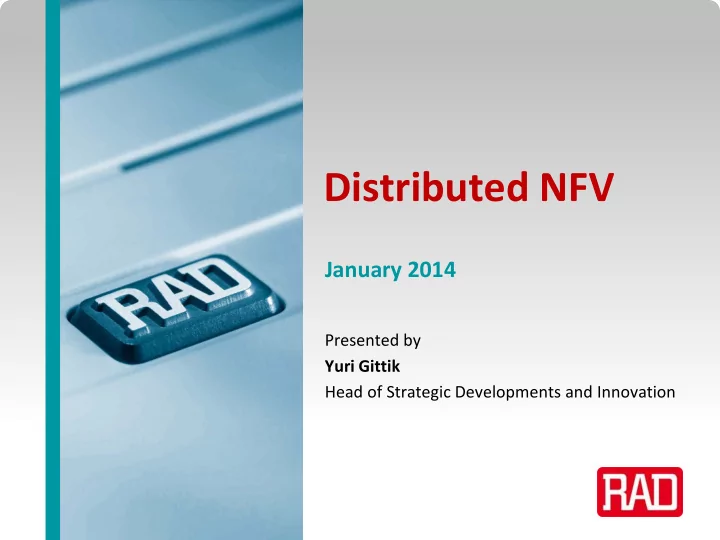

Distributed NFV January 2014 Presented by Yuri Gittik Head of Strategic Developments and Innovation Distributed NFV – January 2014 Slide 1
Agenda • Background on the Distributed NFV (D-NFV) Approach • Virtualization at the Customer Site • RAD’s D-NFV Proposal: Customer-Site Virtualization Distributed NFV – January 2014 Slide 2
NFV: Network Functions Virtualization NFV advocates virtualizing service-provider networking and IT functionalities using software hosted on general-purpose servers Distributed NFV – January 2014 Slide 3
Expanding NFV’s Implementation Scope Primarily Mobile Networks & Services Enterprise Services • Addressing and • New network facilitating capabilities migration to • Value-added LTE/LTE-A services • Functionality: ePC, IMS, PCRF,… Distributed NFV – January 2014 Slide 4
NFV: The Distributed Model The most prevalent approach to NFV concentrates functions in centrally-located data centers (DC) or network nodes (CO/POP) Distributed NFV allows service provider-controlled functions to reside anywhere – including at the customer premises Data Center CO/PoP Customer Premises Customer Network Network Distributed NFV Distributed NFV – January 2014 Slide 5
The D-NFV Approach: From the NFV White Paper… Explicitly declared from the very beginning in the introductory NFV White Paper “… Leverage standard IT virtualization technology to consolidate many network equipment types onto industry standard high volume servers, switches and storage that can be located in DCs, Network Nodes and in the end-user premises.” 1 1 Network Functions Virtualization – Introductory White Paper, October 2012 Distributed NFV – January 2014 Slide 6
D-NFV …To New Documents by the ETSI NFV Industry Specification Group • Terminology Paper – Network Point of Presence: A location where a Network Function is implemented…Example of NPOP locations include central offices, customer premises , mobile devices, and data centers • End-to-End Architecture Paper : One of NFV’s objectives is to ensure greater flexibility in assigning VNFs to hardware – Software to be located at the most appropriate places, e.g., at customer premises, at network PoP, in central offices or data centres CO/PoP Customer Premises Data Center Distributed NFV – January 2014 Slide 7
Why Distributed NFV? Distributed NFV bucks the trend of hosting all functionalities in centrally-located Data Centers What is the rationale behind D-NFV ? The following arguments make the D-NFV case: • Costs – Networking vs. computing/IT resources As well as: • Functions Feasibility • Performance • Policy Conformance Distributed NFV – January 2014 Slide 8
Agenda • Background on the Distributed NFV (D-NFV) Approach • Virtualization at the Customer Site • RAD’s D-NFV Proposal: Customer-Site Virtualization Distributed NFV – January 2014 Slide 9
Virtualization at the Customer Site: CPE Virtualization Re-locating CPE functionality in the network: • Replace vendor-specific embedded functionality with… • … a next-generation customer-site device, paired with virtualized functionality running in the network – some functionalities (OAM, QoS) remaining at the customer site Addressed in the NFV ISG “Use Cases” document (Oct’13) • Virtualization meaning: shared or/and run as VNF on VM infrastructure Customer Premises Data Center CO/PoP Customer Network Network CPE “Centripetal” NFV : From the customer site towards the network Distributed NFV – January 2014 Slide 10
Virtualization at the Customer Site: Distributed NFV Enable D-NFV implementation beyond the datacenter – Locating NVF at the most appropriate* places * - Based on: Feasibility, performance, cost, policy Customer Premises Data Center CO/PoP Customer Network Network “Centrifugal” NFV : From the network towards the customer site Distributed NFV – January 2014 Slide 11
NFV at the Customer Site: Why? Criteria Description Feasibility • Some functions must be located at the customer site, e.g., end-to-end security, traffic conditioning , encryption, WAN optimization • Some functions perform better at the customer site, e.g., end-to-end QoS, application QoE monitoring Performance • Some functions may degrade due to network constraints (bandwidth, delay, availability) • Need for higher network performance and resiliency may lead to cost Cost increase, even with data centers’ economies of scale • Some functions need to remain close to the customer due to corporate privacy, security and access policies Policy • Regulatory restrictions (e.g., on moving data across jurisdictions) Virtualized Embedded SW/HW Virtualized Value Added Network Functions Capabilities Functionality Distributed NFV – January 2014 Slide 12
Physics: Resultant Force Once embedded functionalities are virtualized: • Customer site functionalities are free to move towards the (data) center • Functionalities conventionally located at the (data) center are free to move towards the customer premises Distributed NFV – January 2014 Slide 13
Agenda • Background on the Distributed NFV (D-NFV) Approach • Virtualization at the Customer Site • RAD’s D-NFV Proposal: Customer-Site Virtualization Distributed NFV – January 2014 Slide 14
RAD’s Solution The solution that integrates SP-controlled network termination and virtual machine hosting: L2/L3 NID with integrated standard x86 platform Customer Premises Customer Network Network NFV-NID • Application examples (by 3 rd -parties or RAD’s) – Firewall – Analysis tools (TCPdump, Wireshark) – Application awareness – IP telephony – WAN optimization Distributed NFV – January 2014 Slide 15
Customer-Site NFV Economics Reduced Costs Increased Revenues and - Faster service Service Agility introduction, activation - More premium services and upgrade without (SLA assurance, QoE, policy truck-rolls compliance) - Reduced equipment - Reduce Time-to-Market footprint at customer (quicker time to revenue, less churn) site - Flexible service packaging - Lower on-site installation, - Ubiquitous services over maintenance and any access energy costs - Higher service adoption - Effective deployments (“try-and-buy” offering) Distributed NFV – January 2014 Slide 16
Thank You For Your Attention www.rad.com Distributed NFV – January 2014 Slide 17
Recommend
More recommend